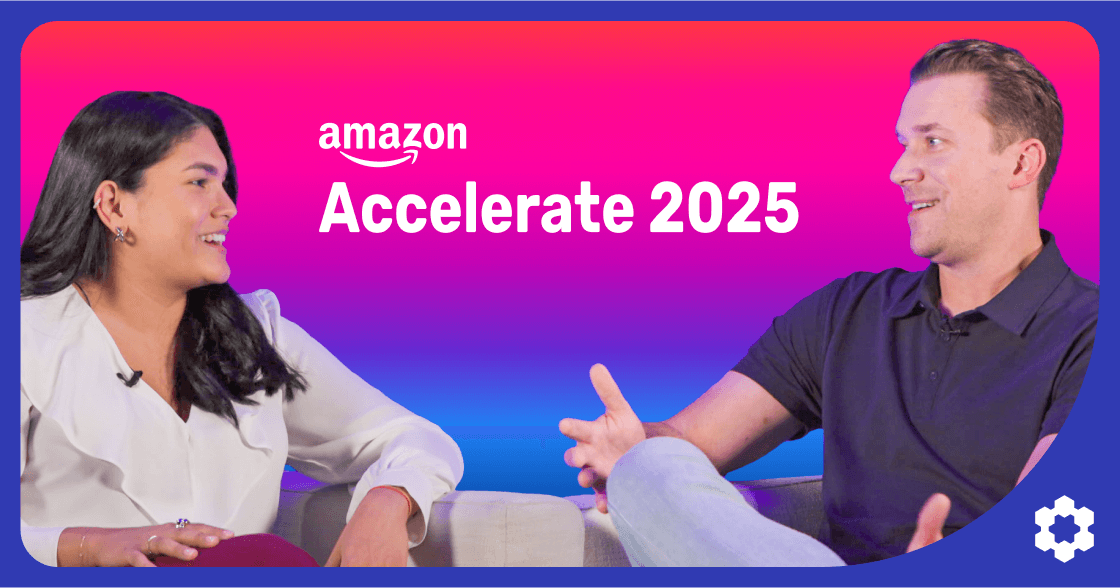Top Amazon Sellers News This Week
This week’s ecomm roundup is headlined by a wave of AI-driven innovation–especially from Amazon, which continues to revolutionize how customers discover and consume content on its platform.
- Amazon rolls out AI-powered audio for shopping and publishing: Amazon is testing podcast-style audio summaries on product pages, where two AI “hosts” chat about features and reviews. At the same time, Audible has launched an AI audiobook production system with 100+ lifelike voices in multiple languages, helping publishers quickly create and scale narrated content.
- Google and Meta announce AI tools to automate digital advertising: Google is launching Marketing Advisor, a Chrome-based AI assistant that offers real-time campaign insights and strategy tips within Google Ads. Meta, meanwhile, is pushing for full ad automation, letting businesses set goals and budgets while AI handles everything from creating to optimizing ads. Both moves suggest a pivot toward hands-free, AI-driven advertising.
As AI continues to transform how products are discovered and ads are delivered, this week’s Amazon updates offers a glimpse into a future that’s faster, smarter, and more automated than ever. Keep reading to see how these developments could impact your business.
AI-Powered Audio Comes to Amazon Listings and Audiobooks
Amazon’s generative AI push is reshaping shopping and publishing, from smart product summaries to automated audiobooks.
New Amazon AI Audio Summaries Help Shoppers Decide Faster
Amazon has begun testing a new generative AI feature that creates short-form audio summaries of product pages, designed to help customers make faster, more informed buying decisions.
- On the Amazon shopping app, two AI “hosts” discuss a product’s key features, drawing from product descriptions, customer reviews, and even third-party web content.
- The experience mimics a podcast-style conversation, offering relatable, digestible insights—for example, highlighting that the SHOKZ OpenRun Pro headphones use bone conduction for sound and might suit athletes or people who dislike in-ear devices.
- These summaries are currently available to select US Amazon shopping app users on specific products like the Ninja Blender and OSEA Undaria Algae Body Oil.
- Customers can tap the “Hear the highlights” button on the product detail page to listen while multitasking.
What it Matters for Sellers
- Your product reviews and listings now contribute directly to what potential buyers hear.
- A compelling product page and clear, positive reviews can improve how your item is featured in these summaries.
- The feature targets “considered purchases,” meaning products with more complex selling points that benefit from deeper explanation.
Audible Rolls Out AI-Narrated Audiobook Tools for Publishers
On the content creation side, Amazon is leveraging the same generative AI momentum to expand audiobook production at scale. Through its Audible platform, Amazon is now offering AI narration tools that let publishers:
- Choose from over 100 synthetic voices across English, Spanish, French, and Italian—with accents and dialect options.
- Use two workflows: a fully managed Audible-led process or a self-service option powered by Amazon’s AI.
- Tap into text-to-speech or speech-to-speech translations (coming later in 2025), potentially making books available in multiple languages using the same narrator’s voice and tone.
Why it Matters for Publishers and Content Creators
- Lower the barrier to entry for audiobook production—no voice actors or recording studios required.
- Expand your reach to global audiences with faster translation and localization.
- Take advantage of Amazon’s mission to support “every book in every language,” with scalability baked in.
Together, these AI audio initiatives mean one thing: making content consumption easier, faster, and more immersive. Whether you’re shopping for headphones or publishing your next book, audio is now a central channel—and AI is leading the charge.
Unlock the future of ecommerce with our AI Revolution white paper. Discover how leading Amazon sellers leverage AI for personalization, product research, and advertising optimization. Download your free guide now and start integrating AI.
AI Ad Arms Race: Google, Meta, and Amazon Define the Future of Automation—But Will Sellers Surrender Control?
The advertising world is entering a new era—one where AI agents not only recommend strategies but actually run your campaigns.
At Google’s 2025 Marketing Live event, the tech giant announced a wave of “agentic” AI tools that automate much of what marketers once did manually. But Google isn’t alone.
Meta is pushing an even more radical “Black Box” vision (a system that gives outputs without revealing how it makes decisions), where advertisers simply state their goals and budget, and AI does the rest—no creative, no targeting, no measurement needed. Meanwhile, Amazon appears to be charting a more cautious path, blending automation with transparency in what some are calling a “copilot” approach.
These developments show that Big Tech is no longer just suggesting improvements—it’s taking the wheel.
Google Marketing Advisor: AI That Works For You
Google introduced Marketing Advisor, an AI agent embedded directly in Chrome that can independently perform marketing tasks across websites and platforms. Unlike traditional AI advertising tools that merely suggest actions, this Chrome AI assistant can actually implement changes after receiving user consent. Other capabilities include:
- Monitor seasonal trends for their product categories. Suppose you sell insulated water bottles. In late April, the Google AI tool spots rising interest in “summer hiking gear” and flags an early seasonal spike. It recommends boosting ad spend and updating creative with summer messaging by early May.
- Spot missing tags on websites and install them with approval. Imagine you’re running Google ads, but the AI notices your “add to cart” event isn’t firing properly on mobile. It alerts you, highlights the affected code, and provides a fix that inserts the correct tag snippet. You review the change and click “approve,” and the AI pushes it live through your connected tag manager.
- Provide step-by-step strategy recommendations directly on relevant web pages. For instance, you’re reviewing your skincare landing page when the AI flags high bounce rates and suggests A/B testing a shorter headline and adding a video testimonial. You launch the test with one click—right on the page.
In an interview with AdWeek, Dan Taylor, Google’s VP of Global Ads, described this AI tool as “a new frontier” that makes it easier for businesses to achieve results with minimal manual intervention.
Drive high-converting external traffic to your Amazon listings with PixelMe, our AI-powered external traffic solution. Boost your organic rank, maximize ROAS, and unlock Amazon’s Brand Referral Bonus program with ease. Get your free ASIN audit now.
Meta Bets Big on Full AI Ad Control
Meta CEO Mark Zuckerberg is embracing AI automation even more radically. On Ben Thompson’s Stratechery podcast, he painted a picture of advertising where businesses:
- Upload a campaign objective.
- Connect their bank account.
- Let Meta do the rest–no creative, no targeting, no measurement required.
“We’re going to get to a point where you’re a business, you come to us, you tell us what your objective is… you don’t need any creative, you don’t need any targeting demographic, you don’t need any measurement,” Zuckerberg explained.
Meta’s ad automation tools can already generate thousands of ad variations, identify ideal demographics, and run A/B tests at a scale human teams can’t match. This “ultimate business agent” promises simplicity—but at a cost.
However, advertisers should be wary of ethical issues, over-reliance on generative AI, and user fatigue from spammy ads flooding platforms like Facebook and Instagram. Zuckerberg’s “Black Box” vision might be advertising with zero transparency—and advertisers have to take Meta’s word on performance.
Amazon’s Measured Middle Path
While Meta barrels toward full autonomy and Google is taking a more guided approach— Amazon is opting for an even more measured path by offering:
- DSP Performance+ and Brand+ suggest Amazon’s move toward optimization engines.
- AI ad tools like Creative Studio and Video Generator speed up production but still require brand inputs.
- Amazon’s Buy for Me and Rufus serve shoppers, not marketers—evidence that automation is focused on enhancing, not replacing, the user experience.
- Transparency through tools like Amazon Marketing Cloud (AMC).
- Strategic storytelling opportunities in high-margin ad formats like Sponsored TV and Twitch.
Industry experts believe that Amazon is steering toward a “copilot model” rather than a completely closed system because of structural limitations, such as the separation of retail and ad data, and Amazon’s emphasis on product pages as core creatives.
As independent retail media strategist Katie McKee notes:
“Amazon, like Meta, is incredibly data-rich. So offering a done-for-you tool would be particularly efficient. However, most of the useful data is on the Amazon retail side and due to regulations, can’t be shared to its sister property at Amazon Ads. This cuts deeply into how efficient a tool they could build without regulations changing.”
She also added that: “Product pages are the creative. Strip the hero image, bullets, and reviews out of an ad and conversion tanks. Amazon can compress the asset workflow, but it can’t delete it.”
Overall, all signs point to the future of advertising being written by algorithms, but sellers and advertisers still hold the pen—if they choose to use it.
Expand your reach with DSP Prime. Our expert-managed advertising solution leverages Amazon’s first-party data to connect your brand with high-intent audiences across websites, apps, and streaming platforms. Get your customized growth plan now and launch in just 10 days.
Other Amazon Seller Updates This Week
1. Amazon Brand Lift Now Available to Japanese Advertisers
Japanese advertisers can now use Amazon Brand Lift to measure the effectiveness of upper and mid-funnel Amazon Ads campaigns. This tool surveys Amazon’s engaged Shopper Panel to provide actionable insights on brand awareness, preference, favorability, and more—helping advertisers fine-tune their DSP strategies with data-driven clarity.
2. Set Minimum & Maximum Thresholds for AWD Auto-Replenishment
Sellers using Amazon Warehousing and Distribution (AWD) can now set specific minimum and maximum FBA inventory thresholds per SKU. This added control helps sellers better manage stock for steady-demand products, seasonal items, and new launches while avoiding overstocking or stockouts.
3. Send to Amazon Workflow Gets Shipment & Cost Visibility Upgrades
Amazon has updated the Send to Amazon workflow to show if shipments qualify for Amazon-optimized splits and to display estimated shipping costs upfront. These updates help sellers make informed decisions during shipment creation by comparing fulfillment and shipping options for both domestic and international deliveries.
4. Increase Sales by up to 20% with A+ Content
Amazon reports that A+ Content can boost sales by up to 8% for Basic and 20% for Premium versions. Available to registered brand owners, it lets sellers enhance listings with rich media like images, videos, and comparison charts—helping reduce confusion, build trust, and tell a compelling brand story. For best practices, check out this article.
5. New Selection Success Guide Helps Accelerate Product Launches
Aimed at sellers introducing new products, this guide provides strategies for selling your first units faster. It includes tips on boosting visibility, writing engaging content, collecting quality reviews, and using Amazon programs and incentives to drive early conversions.
6. FAA Approves Amazon Drone Delivery of Lithium-Ion Battery Products
Amazon’s Prime Air drones are now cleared to deliver products with lithium-ion batteries, such as phones and earbuds, in select areas of Arizona and Texas. The updated process improves delivery accuracy, removes the need for QR codes, and enables 60-minute drop-offs—bringing ultra-fast fulfillment to eligible customers.
Stay in Control While AI Takes the Wheel
AI is reshaping how products are discovered, ads are delivered, and content is consumed across Amazon, Meta, and Google. But even as automation accelerates, smart sellers have opportunities to stay ahead without surrendering control.
Here are a few strategies to make the most of this AI-driven future:
- Optimize for voice and audio formats: With Amazon experimenting with AI-generated audio summaries and Audible offering automated narration, now’s the time to ensure your listings communicate clear, engaging benefits that work just as well when spoken aloud.
- Lean into copilot AI ad tools—without outsourcing your brand: Tools like Creative Studio and Video Generator can save time, but they still need your voice. Use AI to streamline production, not replace your storytelling.
- Monitor AI-powered campaign outputs critically: Whether you’re using DSP Performance+ or testing Meta’s automation tools, set clear performance benchmarks and review results frequently. AI can scale, but it still needs strategic oversight.
For nearly four years, we’ve kept sellers informed with our Amazon Sellers Newsletter, publishing over 200 issues packed with policy changes, announcements, and community events. Subscribe or share with your team to get these insights delivered weekly.








